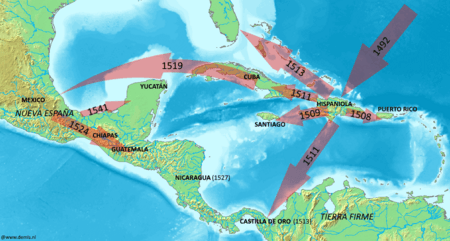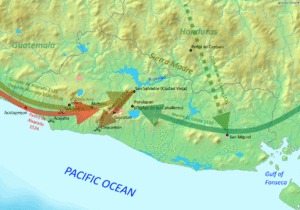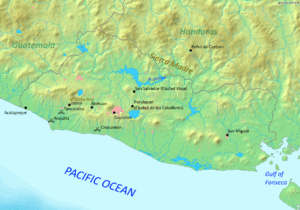Spanish conquest of El Salvador facts for kids
Quick facts for kids Spanish conquest of El Salvador |
|||||||||
|---|---|---|---|---|---|---|---|---|---|
| Part of the Spanish colonization of the Americas | |||||||||
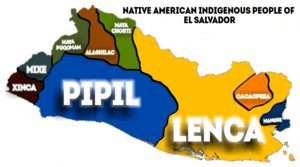 Indigenous ethnic groups of El Salvador, prior to Spanish conquest |
|||||||||
|
|||||||||
| Belligerents | |||||||||
|
Indigenous peoples of El Salvador, including:
|
|||||||||
| Commanders and leaders | |||||||||
The Spanish conquest of El Salvador was a series of battles and events where Spanish conquistadors (explorers and soldiers) took control of the land that is now El Salvador. This happened between 1524 and about 1539. El Salvador is the smallest country in Central America. It has two mountain ranges and a tropical climate with wet and dry seasons.
Before the Spanish arrived, many different native groups lived in El Salvador. These included the Pipil, Lenca, Xinca, and Maya. They used weapons like spears, bows and arrows, and wooden swords with sharp stone blades. They also wore protective clothing made of thick cotton.
The Spanish soldiers were mostly volunteers. They didn't get a regular salary. Instead, they hoped to get rich from the treasures and land they conquered. Many of them were experienced fighters from battles in Europe. The Spanish had strong weapons like steel swords, firearms, and crossbows. They also used light cannons. Metal armor was too hot in Central America, so the Spanish often wore padded cotton armor like the natives. The Spanish also had many native allies who helped them fight.
The first big Spanish attack on El Salvador was in 1524. It was led by Pedro de Alvarado. He tried to conquer the Pipil area of Cuzcatlan but had to go back to Guatemala by July 1524. The next year, Gonzalo de Alvarado started a Spanish town called San Salvador. But native fighters destroyed it in 1526 during a big uprising.
Pedro de Alvarado came back to fight in El Salvador in 1526 and 1528. In 1528, his cousin, Diego de Alvarado, rebuilt San Salvador. He also gave land and native workers to his supporters. The native uprising finally ended in 1528 when the Spanish captured a strong native fortress.
Contents
- What Was El Salvador Like Before the Spanish Arrived?
- How the Spanish Began Their Conquests
- The Conquistadors and Their Allies
- The Impact of New Diseases
- Spanish Explorers Reach El Salvador
- The Conquest of El Salvador
- How El Salvador Was Organized After the Conquest
- Where We Learn About This History
- Images for kids
- See also
What Was El Salvador Like Before the Spanish Arrived?
Before the Spanish conquest, El Salvador was part of the larger Mesoamerican cultural area. The central and western parts of the land were home to the Pipil. These people were related to the Aztecs of Mexico. The Pipil had three main areas in El Salvador: Cuscatlan, Izalco, and Nonualco. Cuscatlan was the largest, stretching from the Paz River to the Lempa River. Izalco was to the southwest of Cuscatlan and was under its control. The Nonualco area was around the city of Zacatecoluca.
Other native groups in El Salvador included the Ch'orti' and Poqomam (both Maya groups), the Lenca, Xinca, Kakawira, Mangue, and Matagalpa. The cities of the Maya and Pipil were not as big as the ancient Maya cities from earlier times. The Lenca lived east of the Lempa River, and their main kingdom was Chaparrastique. The Ch'orti' and Poqomam lived in the west, near what is now Guatemala. The Mangue and Matagalpa lived in the far east and southeast.
Historians believe that between 130,000 and 1,000,000 people lived in El Salvador when the Spanish arrived. The lower estimates are probably more accurate. The main kingdoms of Cuscatlan, Izalco, and Chaparrastique often fought each other. Smaller groups sometimes rebelled against their larger neighbors. There was a lot of trade, with cacao (chocolate beans) being the most important product. They also traded maize (corn), cotton, and balsam.
Native Weapons and Fighting Styles
The Pipil used weapons made of wood with sharp stone blades. These included long spears, atlatls (spear-throwers), arrows, and the macana. A macana was a wooden sword with sharp obsidian blades, similar to the Aztec macahuitl. These weapons were not as strong as the Spanish steel, horses, and firearms. The Spanish said that the natives of El Salvador wore thick cotton armor. It was about three fingers thick and went down to their feet, making it hard for them to move.
After the Spanish won the first two big battles, the natives often ran away from their towns instead of fighting in open fields. A common tactic was to gather in strong fortresses on mountaintops.
How the Spanish Began Their Conquests
Christopher Columbus found the "New World" for Spain in 1492. After this, private explorers and soldiers made deals with the Spanish Crown. They would conquer new lands in exchange for tax money and the right to rule. The Spanish built their first settlement, Santo Domingo, on the island of Hispaniola in the 1490s. In the early 1500s, they took control of many Caribbean islands. These islands became starting points for their conquests on the mainland.
From Hispaniola, the Spanish went to Puerto Rico in 1508, Jamaica in 1509, Cuba in 1511, and Florida in 1513. They heard stories about the rich Aztec Empire on the mainland. In 1519, Hernán Cortés sailed to explore the Mexican coast. By August 1521, the Aztec capital of Tenochtitlan had fallen to the Spanish. Within three years, the Spanish conquered a large part of Mexico. This new land became known as New Spain. The conquest of Central America was an extension of this campaign against the Aztec Empire.
The Conquistadors and Their Allies
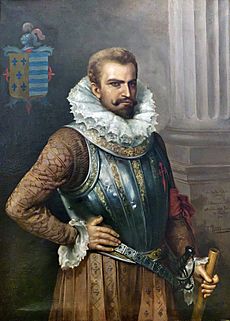
The conquistadors were all volunteers. Most of them did not get a regular salary. Instead, they received a share of the treasures they found, like gold and silver. They also got land and the right to use native labor. Many of these Spanish soldiers were already experienced from wars in Europe. A large number came from the southwestern parts of Spain, like Andalusia and Extremadura.
The conquest of Central America started from three different places: Mexico, Panama, and the Caribbean island of Hispaniola. The Spanish leaders often mistrusted each other and were greedy for more land and wealth.
The conquistadors were helped by many native allies. These included groups like the Tlaxcaltecs and Mexicas from central Mexico. They joined Pedro de Alvarado as he marched south. Other groups like the Zapotecs and Mixtecs joined him in Guatemala and El Salvador. The Kaqchikels also joined him in Guatemala.
A key Spanish strategy was to build new towns in the conquered lands. These towns helped them control the surrounding areas. The Spanish were very upset by the native practice of human sacrifice. This made them try to completely destroy the native religions.
Spanish Weapons and Armor
The steel sword was the biggest advantage for the Spanish in terms of weapons. The conquistadors used wide swords, thin swords (rapiers), firearms like the arquebus, crossbows, and light cannons. Horses were also a huge advantage. Many natives had never seen horses before and were terrified of them. Horses also allowed Spanish soldiers to move quickly on the battlefield. Repeated charges by horsemen could break apart large groups of native foot soldiers. The Spanish also used fierce war dogs in battle.
When attacking native fortresses, the Spanish sometimes built wooden siege engines. These were padded with cotton armor to protect soldiers from enemy arrows and rocks. They helped the attackers climb over walls. Mounted conquistadors used long lances, which also worked as pikes for soldiers on foot. They also used different types of axes and bills. Besides the one-handed sword, a longer, two-handed version was also used. Crossbows were easier to keep working than firearms, especially in the hot, wet climate.
Metal armor was not very useful in the hot, wet climate. It was heavy and rusted easily. In direct sunlight, it became incredibly hot. So, conquistadors often didn't wear metal armor. They might only put it on right before a battle. They quickly started using quilted cotton armor, similar to what the natives wore. They often combined this with a simple metal helmet. Shields were very important for both foot soldiers and horsemen. These were usually round, curved shields made of iron or wood.
The Impact of New Diseases
Diseases brought by the Spanish had a huge impact on the native people. Even before the Spanish soldiers arrived in an area, diseases like smallpox spread ahead of them. A smallpox outbreak hit Guatemala in 1520–1521. It likely spread to the Pipil region of El Salvador too. By the time the Spanish reached El Salvador in 1524, it's thought that up to half of the native population had already died from these new diseases. The natives had no natural protection against them.
It's likely that disease had already weakened the Pipil people before they fought the Spanish in big battles. More waves of diseases spread across Mesoamerica in 1545–1548 and again in 1576–1581. These outbreaks reduced the native populations to only 10% of their original size. This made it very hard for them to fight against the European invaders. The deadliest diseases were smallpox, malaria, measles, typhus, and yellow fever. It's estimated that 90% of the native population died from disease within the first 100 years of European contact.
Spanish Explorers Reach El Salvador
Gil González Dávila and Andrés Niño were the first Spanish explorers to see the coast of El Salvador. This happened in 1522. They sailed northwest along the Pacific coast of Central America from Panama. They briefly landed in the Bay of Fonseca. El Salvador was in a border area between two rival Spanish conquests. One was coming south from Mexico, led by Hernán Cortés and Pedro de Alvarado. The other was coming north from Panama, led by Pedrarias Dávila.
The Conquest of El Salvador
At the time of the Spanish arrival, the land that is now El Salvador was not united under one ruler. This made it harder for the Spanish to conquer it quickly. Each small native kingdom had to be defeated one by one. This was different from Mexico, where the Spanish quickly took over a large empire by capturing its capital, Tenochtitlan. As Spanish power spread from Mexico and Panama, El Salvador was temporarily left in a middle area, not fully controlled by either side.
Spanish towns were often built wherever a conquistador decided, without much planning. This sometimes left them isolated. In 1548, El Salvador officially became part of the Audiencia Real of Guatemala. This larger area stretched from Chiapas (now in southern Mexico) to Costa Rica.
First Spanish Attacks (1524–1528)
Pedro de Alvarado entered El Salvador from Guatemala in the rainy season of 1524. He led an army of 250 Spanish soldiers, including 100 on horseback. He also had 5,000 native allies from Guatemala. The invaders fought and defeated native groups in big battles. They also faced small, surprise attacks. Alvarado crossed the Río Paz from Guatemala on June 6, 1524. He arrived at Mopicalco, which was empty. They continued to Acatepeque, where the people had also fled.
Battle of Acajutla (1524)
From Acatepeque, the Spanish went to Acajutla, on the Pacific coast. On June 8, 1524, they met a large native army ready for battle. Alvarado's army first went close to the native warriors. Then, they pretended to retreat towards a nearby hill. The native forces chased them for about 2 kilometers. When they were close enough, Alvarado ordered his cavalry and foot soldiers to attack. In the battle, all the defending natives were killed. Alvarado wrote that the natives were so weighed down by their thick cotton armor that they couldn't get up once they fell. Many Spanish soldiers were wounded. Alvarado himself was badly hurt by an arrow that went through his leg. He needed a long time to recover and had a permanent limp. The Spanish rested in Acajutla for five days after the battle.
Battle of Tacuzcalco (1524)
Six days after the battle, Alvarado marched northeast to find the city of Tacuzcalco. This city was about 8 kilometers from Acajutla. Spanish scouts captured two native lookouts. They learned that a large native army had gathered near the city. The scouts waited for the main Spanish army. Pedro de Alvarado was in the back because of his wounds, so his brothers led the attack. The Spanish charged the enemy, defeating them and killing many. After this battle, the Pipil refused to fight the Spanish in open battles. They started using surprise attacks instead.
Retreat to Guatemala (1524)
Alvarado rested for two days at Tazuzcalco. Then he went to Miahuaclan, which was empty. Next, he went to Atehuan, near the Pipil capital of Cuzcatlan. Messengers from Cuzcatlan promised to surrender to the King of Spain. But when Alvarado's army arrived, most people had fled. Alvarado ordered them to return, but they refused. He then declared them guilty and made all the Pipil prisoners into slaves.
Even though the Spanish won big battles, they couldn't capture the strong Pipil cities of Cuzcatlan and Izalco. Alvarado was told that there was much difficult land ahead with many cities and people. Frustrated, Alvarado went back to Guatemala to plan his next move. He intended to return in the dry season. He had been in the Cuzcatlan area for seventeen days and left at the end of June 1524.
Founding of San Salvador

Gonzalo de Alvarado founded the town of Villa de San Salvador in early 1525. But native fighters attacked and destroyed it in 1526. This was part of a big Pipil uprising across the Cuzcatlan area. Diego de Alvarado, Pedro de Alvarado's cousin, was sent to reconquer Cuzcatlan that same year. He had 300 native allies, but 160 of them died. Pedro de Alvarado joined him after returning from an expedition. By 1526, El Salvador, Guatemala, and Honduras were full of native wars against the Spanish. Izalco did not join the uprising because it was still recovering from earlier battles.
The fighting lasted two years, with the Spanish constantly battling native resistance. During this time, the natives defended themselves from strongholds on mountains. Pedro de Alvarado made more trips to El Salvador in 1526 and 1528. In 1528, the conquest of Cuzcatlan was finished. This was helped by many native allies from Mexico. On April 1, 1528, Diego de Alvarado rebuilt San Salvador. He gave encomienda rights (control over native labor and land) to his supporters. This site is now called Ciudad Vieja. It's about 8 kilometers south of Suchitoto. The location might have been chosen because it was between the Pipil, Lenca, and Ch'orti' lands. For the first few years, San Salvador was a frontier town always in danger of native attacks.
Battle of Cinacantan (1528)
The uprising around San Salvador was stopped about a month later. The Spanish attacked a mountaintop fortress at Cinacantan, about 5 kilometers south of the modern town of Tamanique. The native fighters had gone to this stronghold after their earlier attack. This uprising was seen as the first native rebellion in Cuzcatlan after the initial invasion and the founding of San Salvador.
A Spanish group, led by Diego de Alvarado and helped by native allies, was sent from San Salvador. They found three or four allied native groups defending the strong fortress called Peñol de Cinacantan ("Rock of Cinacantan"). At least one of these groups was Pipil. The sides of the fortress were very steep, except for one path that was heavily guarded. As the Spanish tried to storm the fortress, the natives threw rocks and shot arrows and spears at them. On the first day, the Spanish attacks were pushed back twice.
Seeing that the fortress was hard to take, the Spanish built a wooden siege engine. This greatly impressed the defenders. One of the native leaders asked for a truce and told the Spanish to return to San Salvador. He promised that the rebellious natives would come to swear loyalty to the King of Spain. The Spanish thought this was a trick. They launched a new attack using their siege tower. They broke through the defenses and killed many defenders. Many others fled in fear. After the fortress fell, the defeated Pipil defenders were given as encomienda to the people of San Salvador.
Spanish Leaders Fight Each Other (1529–1530)
In 1529, Pedrarias Dávila sent an expedition led by Martín de Estete. He wanted to add El Salvador to his lands in neighboring Nicaragua. He even gave control of the unconquered natives in the Gulf of Fonseca to his followers. At that time, Diego de Roxas was in charge of the Spanish forces fighting native resistance. In early 1530, Martín de Estete captured Rojas and marched toward San Salvador. But he couldn't get the support of the people there. So, he set up camp nearby and called it Ciudad de los Caballeros ("City of the Knights").
The acting governor of Guatemala, Francisco de Orduña, sent his captain Francisco López to drive out Estete. López left Guatemala in March 1530 with thirty horsemen and foot soldiers. The people of San Salvador joined the relief force. Estete left his camp and went back towards Nicaragua, taking 2,000 enslaved natives with him. López chased Estete and caught his forces. Estete and his second-in-command fled to Nicaragua. His soldiers surrendered to López. Diego de Rojas was freed, and the enslaved natives were rescued. This stopped Pedrarias Dávila's plans to make El Salvador part of Nicaragua.
Eastern El Salvador (1530–1538)
To protect against more Spanish attacks from the southeast, Pedro de Alvarado built the Spanish town of San Miguel. He also used it as a base to attack the Lenca. A Spanish force, led by Luis de Moscoso Alvarado, had about 120 Spanish horsemen, foot soldiers, and native allies. They crossed the Lempa River and founded San Miguel on November 21, 1530. Besides Spanish colonists, the settlement included allies from Mexico. Most of the Spanish people in San Miguel left El Salvador with Pedro de Alvarado when he went on his expedition to Peru.
Cristóbal de la Cueva, following orders from Jorge de Alvarado in Guatemala, went into Honduras with about 40 men. He wanted to build a new port and road to Guatemala and stop a native uprising there. He was challenged by the governor of Honduras. Eventually, he marched south to San Miguel with his men. This brought much-needed new colonists. San Miguel was refounded as San Miguel de la Frontera by Cristóbal de la Cueva on April 15, 1535. De la Cueva brought the area back under Guatemala's control, even though the governor of Honduras strongly protested. Eastern El Salvador, with San Miguel as its center, became the Province of San Miguel.
In early 1537, San Miguel was cut off by a big Lenca uprising that spread from Honduras. A native army surrounded San Miguel for three days starting March 27. Their surprise attack caught many people unprepared. Between 50 and 60 Spanish colonists were killed, which was more than half of the Spaniards living there. After three days, the attackers were pushed back by Spanish reinforcements. These reinforcements were passing through from Guatemala on their way to Peru. They were also helped by soldiers from San Salvador. This uprising covered El Salvador and was led by the Lenca ruler Lempira. It was centered in Honduras.
Francisco de Montejo, the governor of Honduras, urgently asked San Salvador for more soldiers and supplies. Montejo sent twenty Spaniards with native allies south. But a scouting party was captured by the Spaniards living there. Montejo's group went back to Honduras. On their way, a Lenca force attacked them, killing almost all of them.
The people of San Salvador were worried by the uprising. They sent many weapons, armor, gunpowder, and other supplies to Francisco de Montejo in Honduras. They also sent 100 native allies with 1,000 native porters. More supplies came from the struggling people of San Miguel. By the end of 1538, Lempira's stronghold had been captured by the Spanish. Montejo crossed from Honduras to San Miguel to help stop the remaining native resistance in the area.
How El Salvador Was Organized After the Conquest
By 1539, the Spanish had made enough progress in El Salvador that Cuzcatlan was considered fully peaceful. Right after the Spanish conquest, the conquistadors looked for wealth by enslaving people and mining. But these industries soon failed. So, the colonists turned to farming instead. In 1545, San Salvador was moved to its current location. On September 27, 1546, it was made a city.
El Salvador was first divided into three main areas: Sonsonate (Izalcos), San Salvador (Cuzcatlan), and San Miguel. Sonsonate was an alcaldía mayor (a major administrative district). San Salvador, San Miguel, and Choluteca (now in Honduras) formed the alcaldía mayor of San Salvador. From 1524, all these areas were under the control of Santiago de los Caballeros de Guatemala. In 1542, this control was reorganized as the Real Audiencia de Guatemala, and later the Captaincy General of Guatemala. For religious matters, all of El Salvador was part of the Roman Catholic diocese of Guatemala. The native people of the Izalco region, famous for producing a lot of cacao, were among the most heavily used in the entire Spanish Empire. By the end of the 1500s, this overuse led to the collapse of cacao production in the area.
Where We Learn About This History
The Annals of the Cakchiquels, a native document from Guatemala, tells about Pedro de Alvarado's first trip into El Salvador. Pedro de Alvarado wrote four letters to Hernán Cortés describing his conquest of Guatemala and El Salvador. Two of these letters still exist. One of them talks about his expedition into El Salvador, focusing on military details. It is very useful for understanding the tactics and weapons used, even though it doesn't respect the native culture.
Images for kids
See also
 In Spanish: Conquista de El Salvador para niños
In Spanish: Conquista de El Salvador para niños


